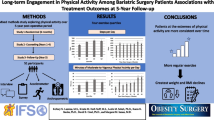Abstract
Background
This study examined self-reported frequency and intensity of physical activity in gastric bypass patients, and the relationship between physical activity and weight loss and psychosocial outcomes during 12-month postoperative follow-up.
Methods
Participants were 131 obese patients who underwent gastric bypass surgery and completed psychometrically established measures assessing physical activity, depression, and physical and mental health preoperatively and at a 12-month follow-up assessment.
Results
Preoperatively, 62.6% of patients reported at least one episode of a minimum of 15 minutes of physical activity per week. This figure increased to 92.4% at 12-month postoperative follow-up. Both the frequency and intensity levels of physical activity episodes increased significantly from preoperative to 12-month postoperative assessments. Hierarchical regression analyses, controlling for demographic variables and preoperative body mass index (BMI), revealed that the intensity of physical activity was significantly associated with postoperative weight loss at 12-month follow-up. Both the frequency and intensity of physical activity were significantly associated with depression, and physical and mental well-being at the 12-month postoperative follow-up.
Conclusion
Gastric bypass patients increase both the frequency and intensity of their physical activity during the first 12 months postoperatively. Higher postoperative intensity levels of physical activity are associated with better weight loss outcomes while both increased frequency and intensity levels of physical activity are associated with better psychosocial outcomes.

Similar content being viewed by others
References
Grilo CM, Brownell KD, Stunkard AJ. The metabolic and psychological importance of exercise in weight control. In: Stunkard A, Wadden TA, editors. Obesity: theory and therapy. New York: Raven; 1993. p. 253–73.
Jeffery RW, Wing RR, Sherwood NE, et al. Physical activity and weight loss: does prescribing higher physical activity goals improve outcome? Am J Clin Nutr. 2003;78:684–89.
Elavsky S, McAuley E. Physical activity and mental health outcomes during menopause: a randomized controlled trial. Ann Behav Med. 2007;33:132–42.
Wolin KY, Glynn RJ, Colditz GA, et al. Long-term physical activity patterns and health-related quality of life in U.S. women. Am J Prev Med. 2007;32:490–99.
Livhits M, Mercado C, Yermilov I, et al. Exercise following bariatric surgery: systematic review. Obes Surg. 2010;20:657–65.
Bond DS, Phelan S, Wolfe LG, et al. Becoming physically active after bariatric surgery is associated with improved weight loss and health-related quality of life. Obesity. 2009;17:78–83.
Elkins G, Whitfield P, Marcus J, et al. Noncompliance with behavioral recommendations following bariatric surgery. Obes Surg. 2005;15:546–51.
Larsen J, Geenen R, van Ramshorst B, et al. Binge eating and exercise behavior after surgery for severe obesity: a structural equation model. Int J Eat Disord. 2006;39:369–75.
Godin G, Sheppard RJ. Godin leisure-time exercise questionnaire. Can J Appl Sport Sci. 1985;10:141–46.
Godin G, Amireault S, Belanger-Gravel A, et al. Prediction of leisure-time physical activity among obese individuals. Obesity. 2009;17:706–12.
Godin G, Shephard RJ. Godin leisure-time exercise questionnaire. Cited by Kriska AM, Caspersen CJ. A collection of physical activity questionnaires for health-related research. Suppl. Med Sci Sports. 1997;29:s36–8.
Beck AT, Steer RA. BDI beck depression inventory manual. San Antonio: Harcourt Brace; 1993.
Fechner-Bates S, Coyne JC, Schwenk TL. The relationship of self-reported distress to depressive disorders and other psychopathology. J Consult Clin Psychol. 1992;64:550–59.
Grilo CM, Masheb RM, Wilson GT. Subtyping binge eating disorder. J Consult Clin Psychol. 2001;69:1066–72.
Svanborg P, Asborg M. A comparison between the Beck Depression Inventory (BDI) and the self-rating version of the Montgomery Asberg Depression Rating Scale (MADRS). J Affect Disord. 2001;64:203–16.
Clark MM, Balsiger BM, Sletten CD, et al. Psychosocial factors and 2-year outcome following bariatric surgery for weight loss. Obes Surg. 2003;13:739–45.
Ware JE, Snow KK, Kosinski M, et al. SF-36 health survey manual and interpretation guide. Boston: New England Medical Center, The Health Institute; 1993.
McHorney CA, Kosinski M, Ware JE. Comparisons of the costs and quality of norms for the Sf-36 Health Survey collected by mail versus telephone interview—results from a national survey. Med Care. 1994;32:551–67.
McHorney CA, Ware JE, Lu JFR, et al. The MOS 36-item short-form health survey (Sf-36).3. Tests of data quality, scaling assumptions, and reliability across diverse patient groups. Med Care. 1994;32:40–66.
Evans RK, Bond DS, Wolfe LG, et al. Participation in 150 min/wk of moderate or higher intensity physical activity yields greater weight loss after gastric bypass surgery. Surg Obes Relat Dis. 2007;3:526–30.
Elavsky S, McAuley E, Motl R, et al. Physical activity enhances long-term quality of life in older adults: efficacy, esteem, and affective influences. Ann Behav Med. 2003;30:138–45.
Fox KR. The influence of physical activity on mental wellbeing. Public Health Nutr. 1999;2:411–18.
Sallis JF, Saelens JE. Assessment of physical activity by self-report: status, limitations, and future directions. Res Q Exerc Sport. 2000;71:1–14.
Bond DS, Jakicic JM, Unick JL, et al. Pre- to postoperative physical activity changes in bariatric surgery patients: self-report vs. objective measures. Obesity. 2010 (in press).
Acknowledgments
This study was supported, in part, by funding from the Rudd Center for Food Policy and Obesity (Dr. Henderson) and grants from the National Institutes of Health (K23 DK071646 (Dr. White) and K24 DK070052 (Dr. Grilo)).
Conflict of interest statement
The authors declare that they have no conflict of interest.
Author information
Authors and Affiliations
Corresponding author
Rights and permissions
About this article
Cite this article
Rosenberger, P.H., Henderson, K.E., White, M.A. et al. Physical Activity in Gastric Bypass Patients: Associations with Weight Loss and Psychosocial Functioning at 12-Month Follow-Up. OBES SURG 21, 1564–1569 (2011). https://doi.org/10.1007/s11695-010-0283-z
Published:
Issue Date:
DOI: https://doi.org/10.1007/s11695-010-0283-z




